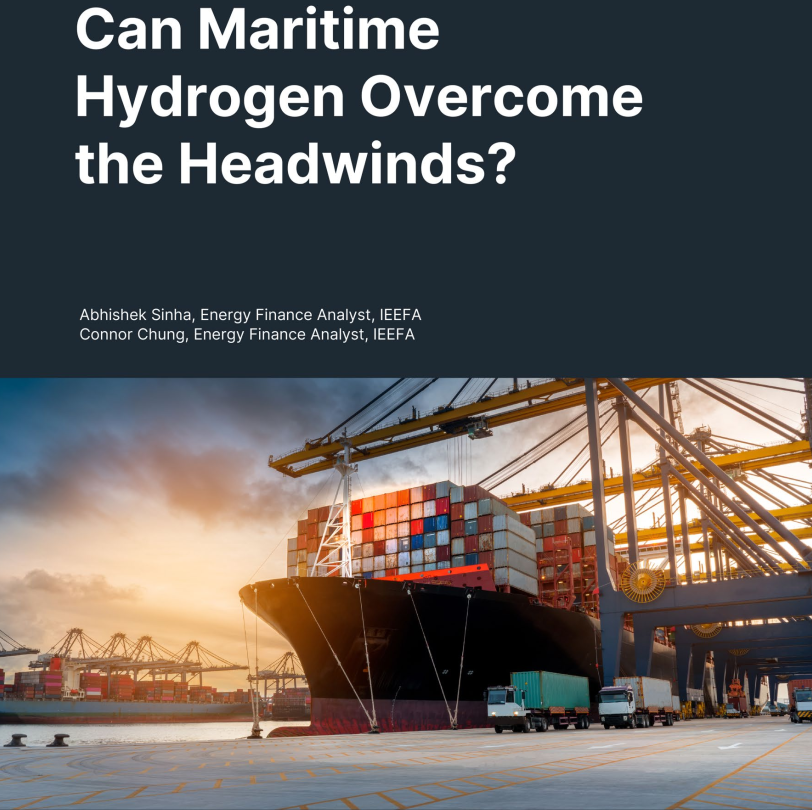When the Institute for Energy Econonomics and Financial Analysis writes a report about maritime hydrogen it is worth a read-through. Even tough they are somewhat underestimating hydrogen itself as fuel. Here is a summary. Find the full report here.

The shipping industry is at a crossroads. It is responsible for over 700 million metric tons of CO₂ emissions every year, making it one of the world’s biggest polluters. With the International Maritime Organization (IMO) targeting net-zero emissions by 2050, the pressure is on to find cleaner alternatives to fossil fuels.
Hydrogen-based fuels—hydrogen, ammonia, and methanol—are often discussed as solutions. But are they really viable? A recent report from IEEFA highlights the potential, challenges, and risks of these fuels. The key takeaway? Hydrogen won’t save shipping overnight.
Hydrogen: Clean, But Costly and Complex
Hydrogen offers a zero-carbon combustion process. In theory, it could power ships without emitting CO₂. But in practice, it faces major barriers.
- Storage challenges: Hydrogen has low energy density, meaning ships need large storage tanks or frequent refueling.
- Infrastructure gaps: Ports lack the bunkering and supply chains to support large-scale hydrogen use.
- High costs: Green hydrogen costs between $4.50–$12/kg, while fossil-based hydrogen is much cheaper at $0.98–$2.93/kg.
- Safety risks: Hydrogen is highly flammable and requires extreme pressure or cryogenic storage.
For now, hydrogen is only viable for short-sea shipping or as a hybrid solution for auxiliary power.
Ammonia: A Promising But Risky Alternative
Ammonia is emerging as a potential maritime fuel, offering better storage and transport capabilities than hydrogen. However, it comes with serious downsides:
- Highly toxic: Ammonia spills could be dangerous for marine life and crews.
- Pollution risks: Without proper emission controls, ammonia combustion releases NOx and nitrous oxide (N₂O), a potent greenhouse gas.
- Lower energy density: Ships using ammonia would need larger storage tanks or frequent refueling stops.
Despite these challenges, engine prototypes for ammonia-powered ships are in development, and some companies are exploring its potential.
Methanol: The Front-Runner for Now
Methanol is currently the most practical option for green shipping. It is:
✔ Easier to store and transport than hydrogen or ammonia.
✔ Compatible with existing port infrastructure—120+ ports already handle methanol.
✔ Gaining traction—more than 200 new methanol-powered ships are on order.
The downside? Feedstock constraints. Green methanol relies on renewable hydrogen and captured CO₂, which are not yet widely available.
The Infrastructure & Cost Problem
None of these fuels can succeed without major investments in infrastructure. Hydrogen and ammonia require new bunkering systems, specialized storage, and refueling networks. Even methanol, the most developed, needs expanded supply chains to meet demand.
Additionally, green hydrogen is too expensive to compete with fossil fuels. Until costs drop, adoption will be slow. Government incentives and private investment are crucial to making these fuels viable.
Regulations & Corporate Action
- IMO Targets: The IMO aims for 30% CO₂ cuts by 2030, 80% by 2040, and net-zero by 2050. However, these are not yet legally binding.
- EU Policies: The FuelEU Maritime Regulation enforces 80% lower greenhouse gas intensity by 2050.
- Industry Commitment: Companies like Maersk, Amazon, and Unilever have pledged to use only zero-carbon ocean freight by 2040.
Conclusion: A Long Road Ahead
Hydrogen-based fuels are not a silver bullet. Methanol leads today, ammonia follows, and hydrogen lags behind. Cost, infrastructure, and safety challenges must be overcome before widespread adoption.
The shipping industry must act now to avoid a dirty hydrogen lock-in—where fossil-based hydrogen becomes the norm. The future of green shipping will depend on policy, investment, and innovation.
What do you think? Will hydrogen become the fuel of the future, or will other technologies take the lead? Let me know in the comments. 🚢💨